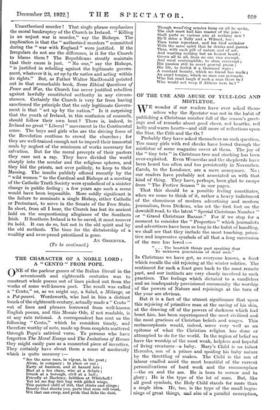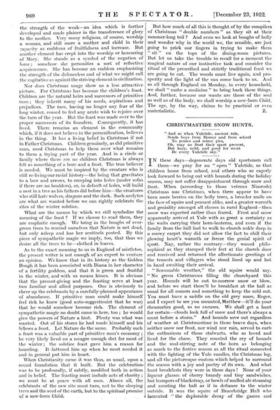OF THE USE AND ABUSE OF YULE-LOG AND MISTLETOE.
WE wonder if our readers have ever asked them- selves why the Spectator was not in the habit of publishing a Christmas number full of the season's greet- ings and of remarks about good cheer, red hearths, red holly and warm hearts—and still more of reflections upon the Star, the Crib and the Ox ?
Probably they have asked themselves no such question. Too many girls with red cheeks have leered through the mistletoe of some magazine cover at them. The joy of the " tiny tots " in Christmas tree and stocking has been over-exploited. Even Wenceslas and the shepherds have been heard too often and too persistently in November. Carols, to the Londoner, are a mere annoyance. No ; our readers have probably not associated us with that kind of thing. They have, perhaps, been glad to escape from " The Festive Season " in our pages.
That this should be a possible feeling constitutes, when we come to think of it, rather a heavy indictment of the clumsiness of modern advertising and modern journalism, from Dickens, who set the - first foot on the downhill road, to the latest " Special Christmas Number " or " Grand Christmas Bazaar." For if we stop for a moment to consider the " Properties " which journalists and advertisers have been so long in the habit of handling, we shall see that they include the most touching, primi- tive and impressive symbols of all that a long succession of the race has loved :— " . . The heartfelt things past speaking dear
To unknown generations of dead men."
In Christmas we have got, as everyone knows, a feast which recalls the old rejoicing at the winter solstice. The sentiment for such a feast goes back to the most remote past, and our instincts are very closely involved in such practices. The feelings which dictated to a candlcless and an inadequately provisioned community the worship of the powers of Nature and rejoicings at the turn of the year are obvious.
But it is a fact of the utmost significance that upon this rejoicing of primitive man at the saving of his skin, at the drawing off of the powers of darkness which had beset him, has been superimposed the most civilized and the most gracious of Christian beliefs and usages. This metamorphosis would, indeed, serve very well as an epitome of what the Christian religion has done or attempted to do for the world. In the region of belief we have the worship of the most weak, helpless and hopeful of living creatures—a baby. Mary's Child is no infant Hercules, son of a prince and spoiling his baby nature by the throttling of snakes. The Child is the son of labour cradled amid the most beautiful of the current personifications of hard work and the commonplace —the ox and the ass. He is born to sorrow and to glory ; He is the type of the lot of man. But, like all good symbols, the Holy Child stands for more than a single idea. He, too, is the type of the small begin- nings of great things, and also of a parallel conception, the strength of the weak—an idea which is further developed and made plainer in the transference of glory to the mother. Very many religions, of course, worship a woman, and still more a mother and child in their -apacity as emblems of fruitfulness and increase. But another element has crept into the worship or honouring of Mary. She stands as a symbol of the negation of force ; somehow she personifies a sort of reflective acquiescence. She has become an emblem emphasizing the strength of the defenceless and of what we might call the cogitative as against the striving element in civilization.
Nor does Christmas usage show us a less attractive picture. For Christmas has become the children's feast. Children are the natural heirs and successors of primitive man ; they inherit many of his needs, aspirations and prejudices. The race, having no longer any fear of the long winter, ceased to feel any acute wish to rejoice over the turn of the year. But the feast was made over to the proper successors of its founders. Consequently, it has lived. There remains an element in the community which, if it does not believe in the personification, believes in the thing. It has a living belief in Christmas if not in Father Christmas. Children genuinely, as did primitive man, need Christmas to help them over what remains to them a trying part of the year. And in a circle or family where there are no children Christmas is always felt as something of a bore and a frost. The true believer is needed. We must be inspired by the creature who is still re-living our racial history—the being that gravitates to a bow and arrows, to creeping into holes (under sofas if there are no boulders), or, in default of holes, will build a nest in a tree as his fathers did before him—the creatures who still hate wolves, dragons and the dark. Such acolytes are what are wanted before we can rightly celebrate the rites of the winter solstice.
What are the means by which we still symbolize the meaning of the feast ? If we choose to read them, they are emphatic enough. We bring in the boughs of ever- green trees to remind ourselves that Nature is not dead, but only asleep and has her sentinels posted. By this piece of sympathetic magic we imply, too, that thus we desire all the trees to be—clothed in leaves.
As to the exact meaning to us in England of mistletoe, the present writer is not enough of an expert to venture an opinion. We know that in its history as the Golden Bough it has been associated with Diana in her character of a fertility goddess, and that it is green and fruitful in the winter, and with us means kisses. It is obvious that the present-giving and the feasting serve at least two familiar and allied purposes. One is obviously to cheer up the celebrants by a carefully-planned appearance of abundance. If primitive man could make himself feel rich he knew (good auto-suggestionist that he was) that he would somehow become rich. The element of sympathetic magic no doubt came in here, too ; he would give the powers of Nature a hint. Plenty was what was wanted. Out of his stores he had made himself and his fellows a feast. Let Nature do the same. Probably such a feast was a valuable part of primitive man's economy ; he very likely lived on a meagre enough diet for most of the winter ; the solstice feast gave him a reason for hoarding. It fattened him up when he most needed it and in general put him in heart.
When Christianity came it was thus, as usual, upon a sound foundation that it built. But the celebration. was to be profoundly, if subtly, modified both in action and in belief. The feasting must include acts of charity ; we must be at peace with all men. Above all, the celebrants of the new rite must turn, not to the sleeping trees and the seed of the earth, but to the spiritual promise of a new-born Child. But how much of all this is thought of by the compilers of Christmas " double numbers " as they sit at their summer-long toil ? And even we look at boughs of holly and wonder why in the world we, the sensible, are just going to prick our fingers in trying to make them " sit " on the tops of the dining-room pictures. But let us take the trouble to recall for a moment the magical nature of our instinctive task and consider the ritual of the prescribed and strictly traditional feast we are going to eat. The woods must live again, and pro- sperity and the light of the sun come back to us. And so all through England on Monday, in every household, we shall " make a medicine " to bring back these things. And, further, because our wants are those of the soul as well as of the body, we shall worship a new-born Child. The age, by the way, claims to be practiCal or even











































 Previous page
Previous page